Analysis of Canadian Apparel Industry: PESTEL and SWOT
VerifiedAdded on 2020/03/23
|6
|1234
|80
Report
AI Summary
This report provides a comprehensive analysis of the Canadian apparel industry, examining its political, economic, social, technological, environmental, and legal (PESTEL) factors. It then delves into a SWOT analysis, identifying the industry's strengths (e.g., technical textiles, innovative design), weaknesses (e.g., financial fundamentals, management structures), opportunities (e.g., US market, mergers), and threats (e.g., globalization, imports from low-wage countries). The report highlights the industry's strong points, such as its manufacturing capabilities and innovative designs, while also pointing out weaknesses like lack of financial knowledge and weak management structures. It emphasizes the importance of the US market as an opportunity and the challenges posed by global competition and cheap imports. The report concludes by offering insights into the industry's strategic position and competitive landscape, providing valuable information for business development and decision-making within the Canadian apparel sector.
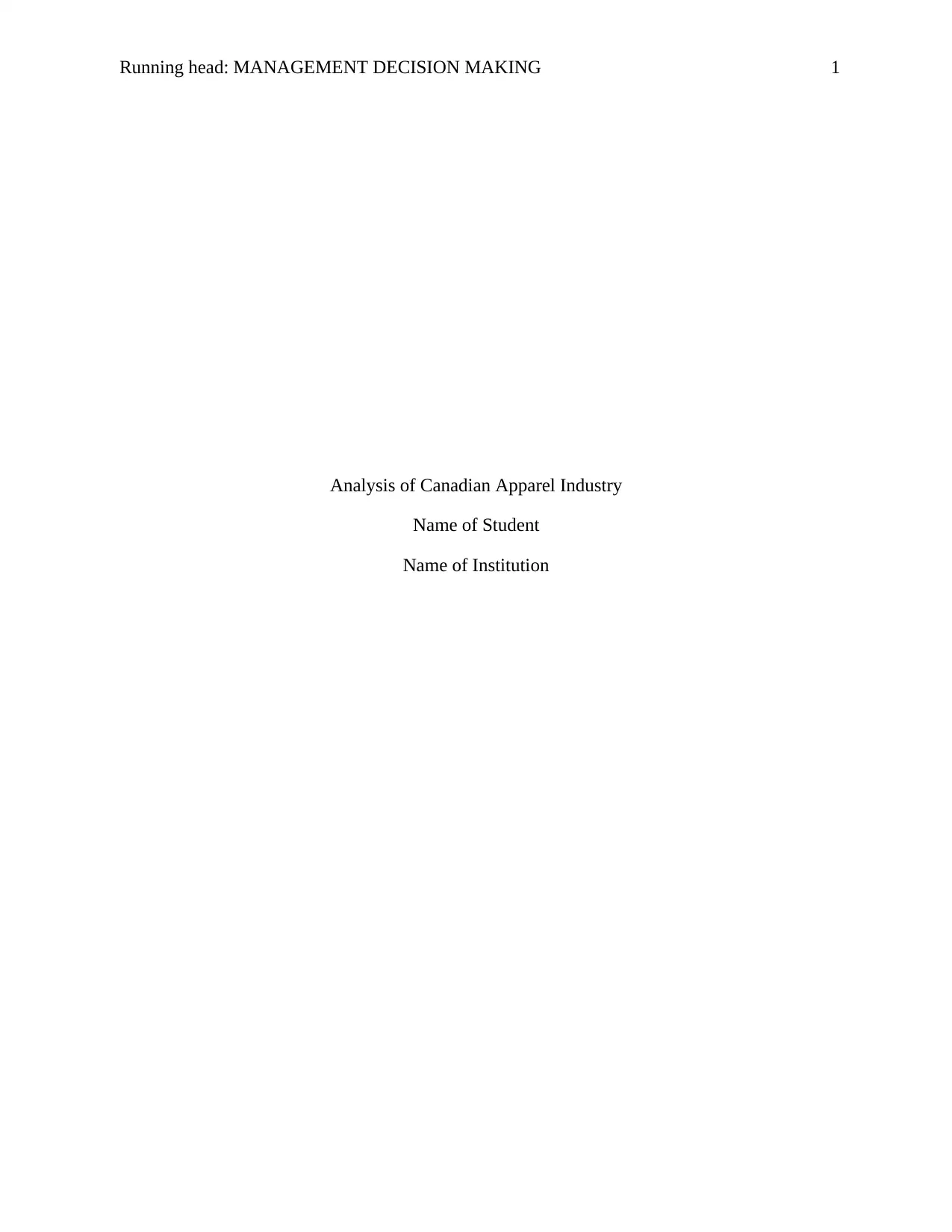
Running head: MANAGEMENT DECISION MAKING 1
Analysis of Canadian Apparel Industry
Name of Student
Name of Institution
Analysis of Canadian Apparel Industry
Name of Student
Name of Institution
Paraphrase This Document
Need a fresh take? Get an instant paraphrase of this document with our AI Paraphraser
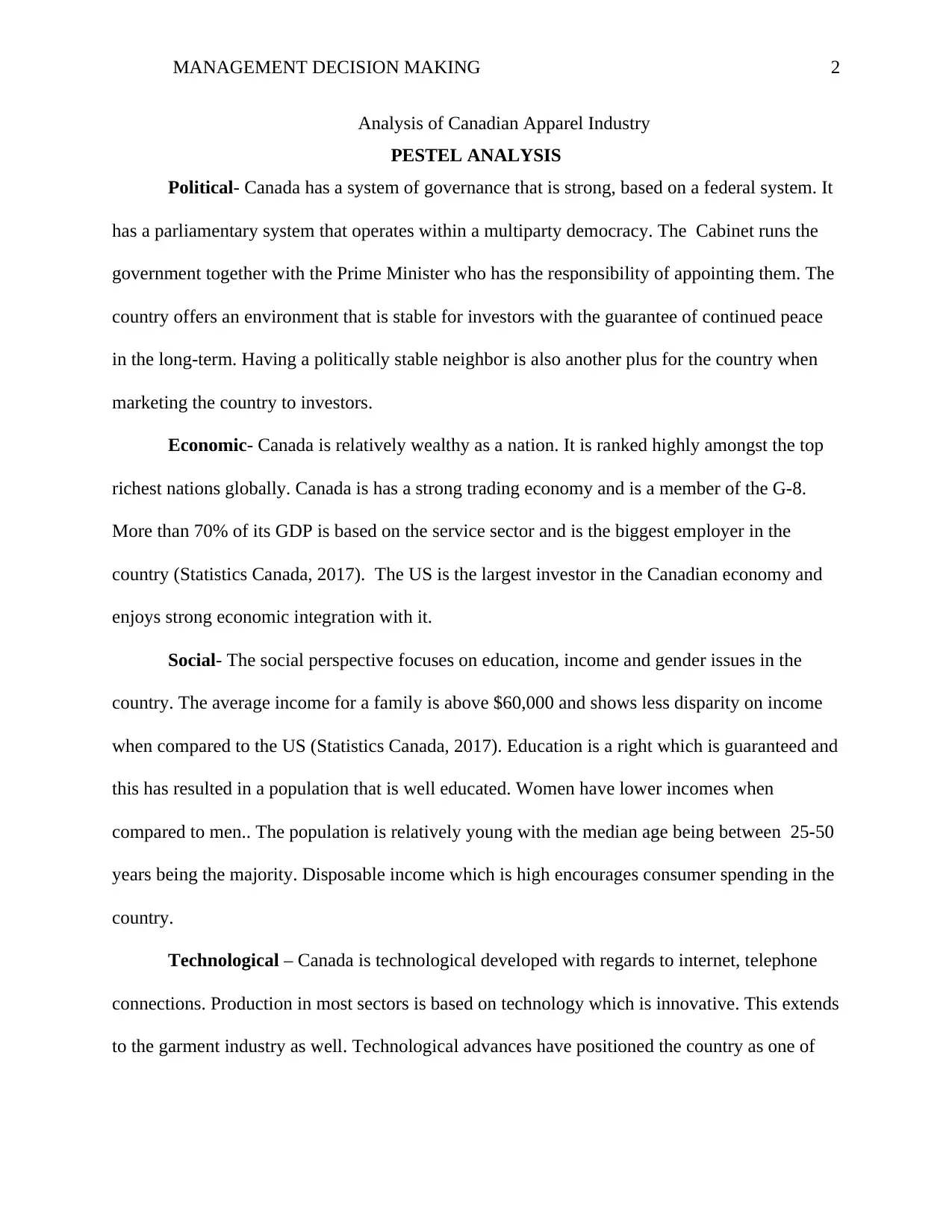
MANAGEMENT DECISION MAKING 2
Analysis of Canadian Apparel Industry
PESTEL ANALYSIS
Political- Canada has a system of governance that is strong, based on a federal system. It
has a parliamentary system that operates within a multiparty democracy. The Cabinet runs the
government together with the Prime Minister who has the responsibility of appointing them. The
country offers an environment that is stable for investors with the guarantee of continued peace
in the long-term. Having a politically stable neighbor is also another plus for the country when
marketing the country to investors.
Economic- Canada is relatively wealthy as a nation. It is ranked highly amongst the top
richest nations globally. Canada is has a strong trading economy and is a member of the G-8.
More than 70% of its GDP is based on the service sector and is the biggest employer in the
country (Statistics Canada, 2017). The US is the largest investor in the Canadian economy and
enjoys strong economic integration with it.
Social- The social perspective focuses on education, income and gender issues in the
country. The average income for a family is above $60,000 and shows less disparity on income
when compared to the US (Statistics Canada, 2017). Education is a right which is guaranteed and
this has resulted in a population that is well educated. Women have lower incomes when
compared to men.. The population is relatively young with the median age being between 25-50
years being the majority. Disposable income which is high encourages consumer spending in the
country.
Technological – Canada is technological developed with regards to internet, telephone
connections. Production in most sectors is based on technology which is innovative. This extends
to the garment industry as well. Technological advances have positioned the country as one of
Analysis of Canadian Apparel Industry
PESTEL ANALYSIS
Political- Canada has a system of governance that is strong, based on a federal system. It
has a parliamentary system that operates within a multiparty democracy. The Cabinet runs the
government together with the Prime Minister who has the responsibility of appointing them. The
country offers an environment that is stable for investors with the guarantee of continued peace
in the long-term. Having a politically stable neighbor is also another plus for the country when
marketing the country to investors.
Economic- Canada is relatively wealthy as a nation. It is ranked highly amongst the top
richest nations globally. Canada is has a strong trading economy and is a member of the G-8.
More than 70% of its GDP is based on the service sector and is the biggest employer in the
country (Statistics Canada, 2017). The US is the largest investor in the Canadian economy and
enjoys strong economic integration with it.
Social- The social perspective focuses on education, income and gender issues in the
country. The average income for a family is above $60,000 and shows less disparity on income
when compared to the US (Statistics Canada, 2017). Education is a right which is guaranteed and
this has resulted in a population that is well educated. Women have lower incomes when
compared to men.. The population is relatively young with the median age being between 25-50
years being the majority. Disposable income which is high encourages consumer spending in the
country.
Technological – Canada is technological developed with regards to internet, telephone
connections. Production in most sectors is based on technology which is innovative. This extends
to the garment industry as well. Technological advances have positioned the country as one of
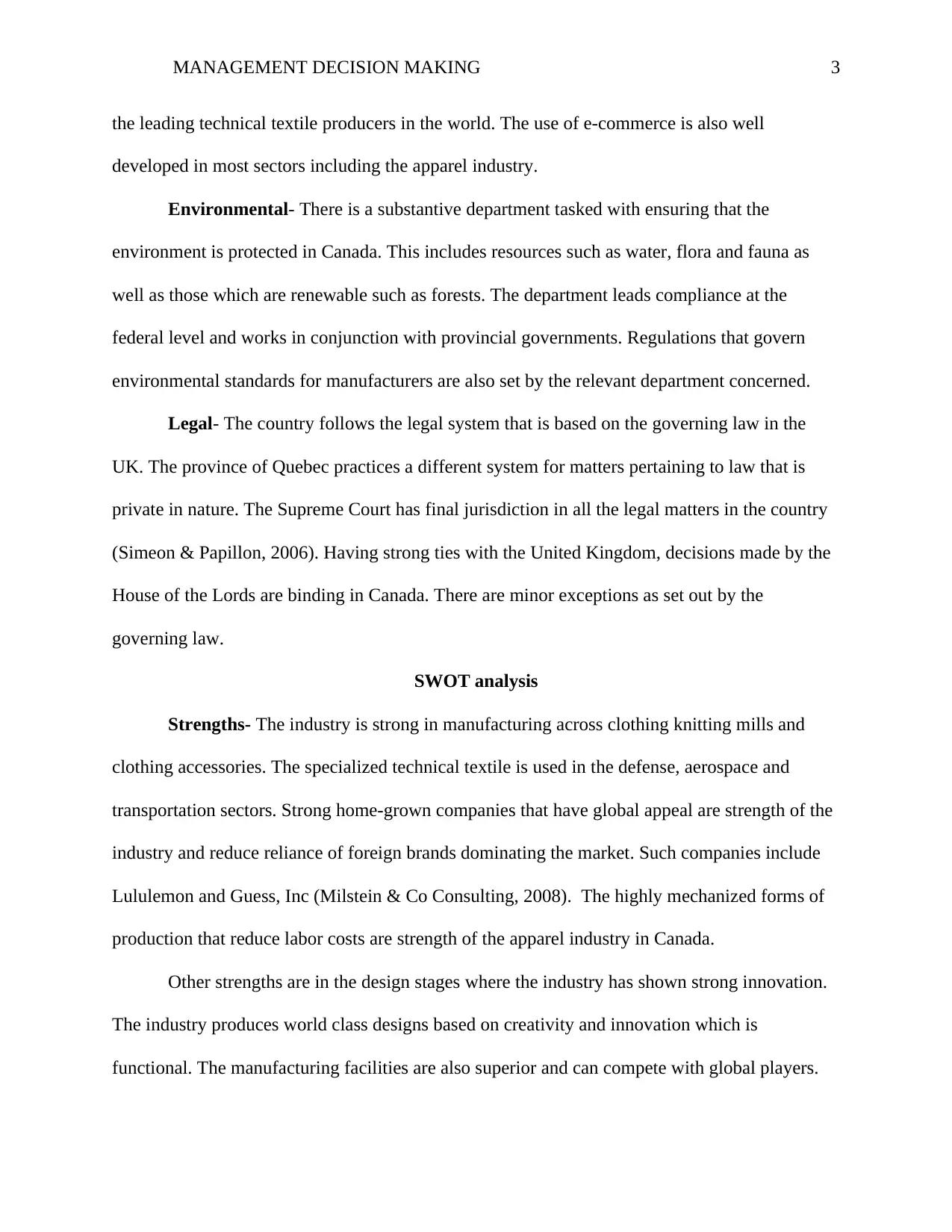
MANAGEMENT DECISION MAKING 3
the leading technical textile producers in the world. The use of e-commerce is also well
developed in most sectors including the apparel industry.
Environmental- There is a substantive department tasked with ensuring that the
environment is protected in Canada. This includes resources such as water, flora and fauna as
well as those which are renewable such as forests. The department leads compliance at the
federal level and works in conjunction with provincial governments. Regulations that govern
environmental standards for manufacturers are also set by the relevant department concerned.
Legal- The country follows the legal system that is based on the governing law in the
UK. The province of Quebec practices a different system for matters pertaining to law that is
private in nature. The Supreme Court has final jurisdiction in all the legal matters in the country
(Simeon & Papillon, 2006). Having strong ties with the United Kingdom, decisions made by the
House of the Lords are binding in Canada. There are minor exceptions as set out by the
governing law.
SWOT analysis
Strengths- The industry is strong in manufacturing across clothing knitting mills and
clothing accessories. The specialized technical textile is used in the defense, aerospace and
transportation sectors. Strong home-grown companies that have global appeal are strength of the
industry and reduce reliance of foreign brands dominating the market. Such companies include
Lululemon and Guess, Inc (Milstein & Co Consulting, 2008). The highly mechanized forms of
production that reduce labor costs are strength of the apparel industry in Canada.
Other strengths are in the design stages where the industry has shown strong innovation.
The industry produces world class designs based on creativity and innovation which is
functional. The manufacturing facilities are also superior and can compete with global players.
the leading technical textile producers in the world. The use of e-commerce is also well
developed in most sectors including the apparel industry.
Environmental- There is a substantive department tasked with ensuring that the
environment is protected in Canada. This includes resources such as water, flora and fauna as
well as those which are renewable such as forests. The department leads compliance at the
federal level and works in conjunction with provincial governments. Regulations that govern
environmental standards for manufacturers are also set by the relevant department concerned.
Legal- The country follows the legal system that is based on the governing law in the
UK. The province of Quebec practices a different system for matters pertaining to law that is
private in nature. The Supreme Court has final jurisdiction in all the legal matters in the country
(Simeon & Papillon, 2006). Having strong ties with the United Kingdom, decisions made by the
House of the Lords are binding in Canada. There are minor exceptions as set out by the
governing law.
SWOT analysis
Strengths- The industry is strong in manufacturing across clothing knitting mills and
clothing accessories. The specialized technical textile is used in the defense, aerospace and
transportation sectors. Strong home-grown companies that have global appeal are strength of the
industry and reduce reliance of foreign brands dominating the market. Such companies include
Lululemon and Guess, Inc (Milstein & Co Consulting, 2008). The highly mechanized forms of
production that reduce labor costs are strength of the apparel industry in Canada.
Other strengths are in the design stages where the industry has shown strong innovation.
The industry produces world class designs based on creativity and innovation which is
functional. The manufacturing facilities are also superior and can compete with global players.
⊘ This is a preview!⊘
Do you want full access?
Subscribe today to unlock all pages.

Trusted by 1+ million students worldwide
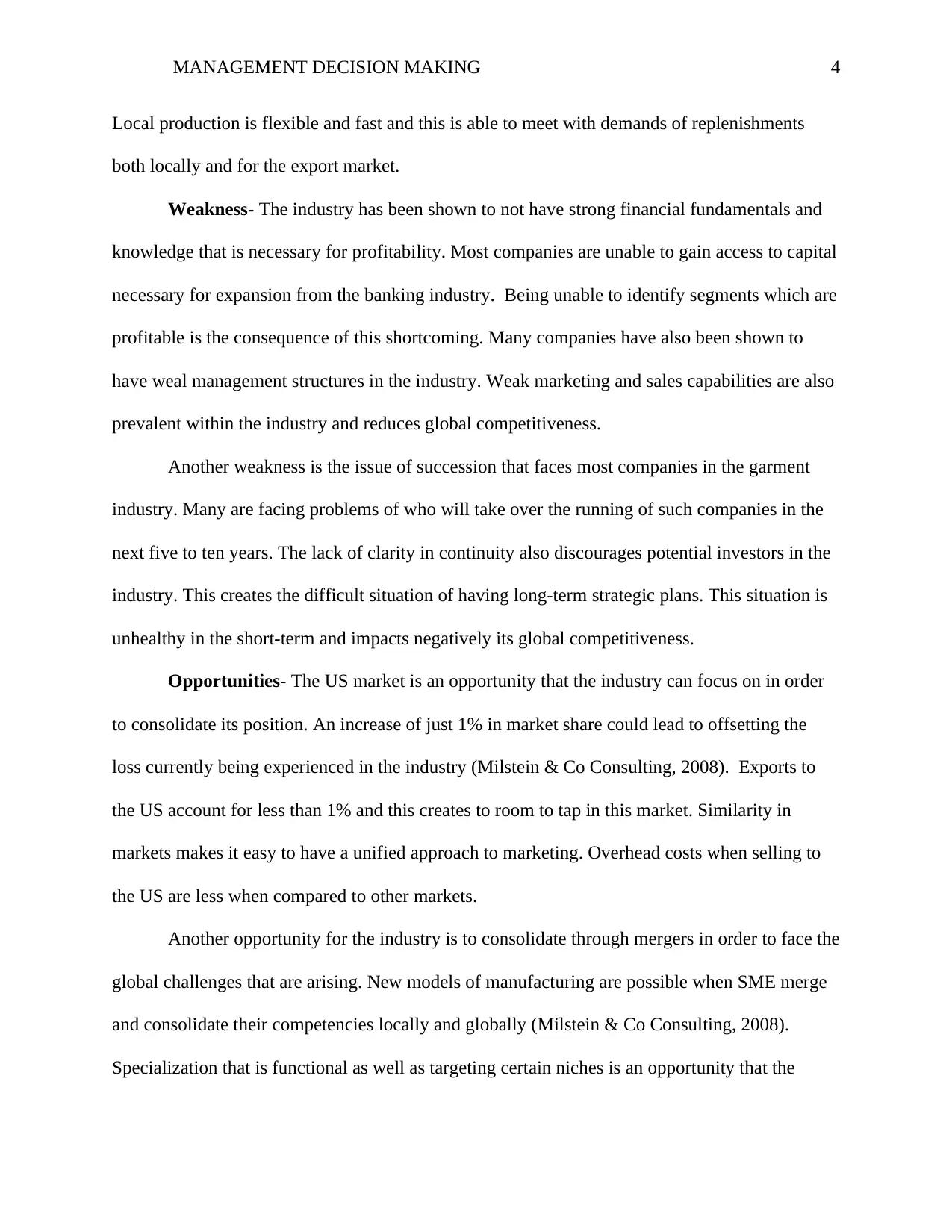
MANAGEMENT DECISION MAKING 4
Local production is flexible and fast and this is able to meet with demands of replenishments
both locally and for the export market.
Weakness- The industry has been shown to not have strong financial fundamentals and
knowledge that is necessary for profitability. Most companies are unable to gain access to capital
necessary for expansion from the banking industry. Being unable to identify segments which are
profitable is the consequence of this shortcoming. Many companies have also been shown to
have weal management structures in the industry. Weak marketing and sales capabilities are also
prevalent within the industry and reduces global competitiveness.
Another weakness is the issue of succession that faces most companies in the garment
industry. Many are facing problems of who will take over the running of such companies in the
next five to ten years. The lack of clarity in continuity also discourages potential investors in the
industry. This creates the difficult situation of having long-term strategic plans. This situation is
unhealthy in the short-term and impacts negatively its global competitiveness.
Opportunities- The US market is an opportunity that the industry can focus on in order
to consolidate its position. An increase of just 1% in market share could lead to offsetting the
loss currently being experienced in the industry (Milstein & Co Consulting, 2008). Exports to
the US account for less than 1% and this creates to room to tap in this market. Similarity in
markets makes it easy to have a unified approach to marketing. Overhead costs when selling to
the US are less when compared to other markets.
Another opportunity for the industry is to consolidate through mergers in order to face the
global challenges that are arising. New models of manufacturing are possible when SME merge
and consolidate their competencies locally and globally (Milstein & Co Consulting, 2008).
Specialization that is functional as well as targeting certain niches is an opportunity that the
Local production is flexible and fast and this is able to meet with demands of replenishments
both locally and for the export market.
Weakness- The industry has been shown to not have strong financial fundamentals and
knowledge that is necessary for profitability. Most companies are unable to gain access to capital
necessary for expansion from the banking industry. Being unable to identify segments which are
profitable is the consequence of this shortcoming. Many companies have also been shown to
have weal management structures in the industry. Weak marketing and sales capabilities are also
prevalent within the industry and reduces global competitiveness.
Another weakness is the issue of succession that faces most companies in the garment
industry. Many are facing problems of who will take over the running of such companies in the
next five to ten years. The lack of clarity in continuity also discourages potential investors in the
industry. This creates the difficult situation of having long-term strategic plans. This situation is
unhealthy in the short-term and impacts negatively its global competitiveness.
Opportunities- The US market is an opportunity that the industry can focus on in order
to consolidate its position. An increase of just 1% in market share could lead to offsetting the
loss currently being experienced in the industry (Milstein & Co Consulting, 2008). Exports to
the US account for less than 1% and this creates to room to tap in this market. Similarity in
markets makes it easy to have a unified approach to marketing. Overhead costs when selling to
the US are less when compared to other markets.
Another opportunity for the industry is to consolidate through mergers in order to face the
global challenges that are arising. New models of manufacturing are possible when SME merge
and consolidate their competencies locally and globally (Milstein & Co Consulting, 2008).
Specialization that is functional as well as targeting certain niches is an opportunity that the
Paraphrase This Document
Need a fresh take? Get an instant paraphrase of this document with our AI Paraphraser
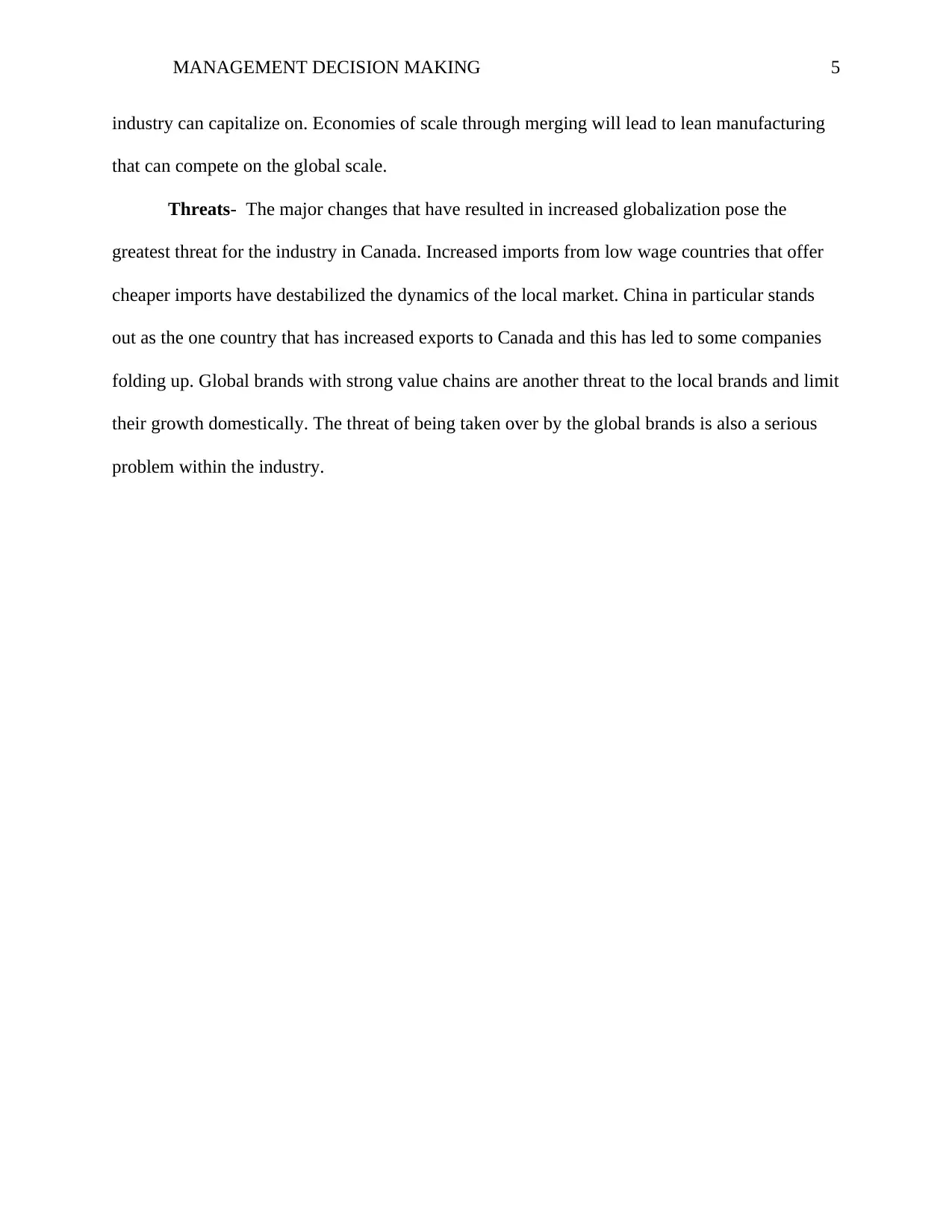
MANAGEMENT DECISION MAKING 5
industry can capitalize on. Economies of scale through merging will lead to lean manufacturing
that can compete on the global scale.
Threats- The major changes that have resulted in increased globalization pose the
greatest threat for the industry in Canada. Increased imports from low wage countries that offer
cheaper imports have destabilized the dynamics of the local market. China in particular stands
out as the one country that has increased exports to Canada and this has led to some companies
folding up. Global brands with strong value chains are another threat to the local brands and limit
their growth domestically. The threat of being taken over by the global brands is also a serious
problem within the industry.
industry can capitalize on. Economies of scale through merging will lead to lean manufacturing
that can compete on the global scale.
Threats- The major changes that have resulted in increased globalization pose the
greatest threat for the industry in Canada. Increased imports from low wage countries that offer
cheaper imports have destabilized the dynamics of the local market. China in particular stands
out as the one country that has increased exports to Canada and this has led to some companies
folding up. Global brands with strong value chains are another threat to the local brands and limit
their growth domestically. The threat of being taken over by the global brands is also a serious
problem within the industry.
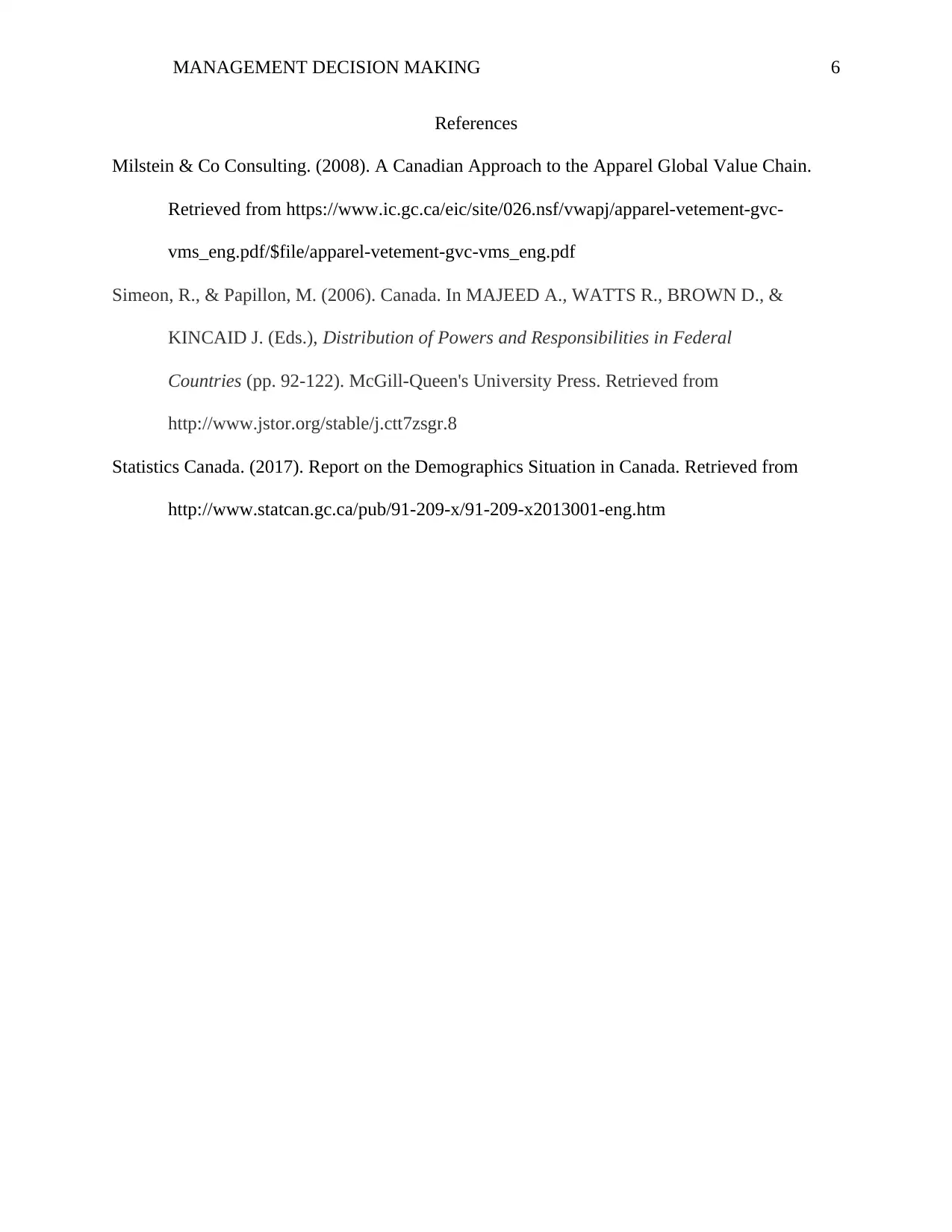
MANAGEMENT DECISION MAKING 6
References
Milstein & Co Consulting. (2008). A Canadian Approach to the Apparel Global Value Chain.
Retrieved from https://www.ic.gc.ca/eic/site/026.nsf/vwapj/apparel-vetement-gvc-
vms_eng.pdf/$file/apparel-vetement-gvc-vms_eng.pdf
Simeon, R., & Papillon, M. (2006). Canada. In MAJEED A., WATTS R., BROWN D., &
KINCAID J. (Eds.), Distribution of Powers and Responsibilities in Federal
Countries (pp. 92-122). McGill-Queen's University Press. Retrieved from
http://www.jstor.org/stable/j.ctt7zsgr.8
Statistics Canada. (2017). Report on the Demographics Situation in Canada. Retrieved from
http://www.statcan.gc.ca/pub/91-209-x/91-209-x2013001-eng.htm
References
Milstein & Co Consulting. (2008). A Canadian Approach to the Apparel Global Value Chain.
Retrieved from https://www.ic.gc.ca/eic/site/026.nsf/vwapj/apparel-vetement-gvc-
vms_eng.pdf/$file/apparel-vetement-gvc-vms_eng.pdf
Simeon, R., & Papillon, M. (2006). Canada. In MAJEED A., WATTS R., BROWN D., &
KINCAID J. (Eds.), Distribution of Powers and Responsibilities in Federal
Countries (pp. 92-122). McGill-Queen's University Press. Retrieved from
http://www.jstor.org/stable/j.ctt7zsgr.8
Statistics Canada. (2017). Report on the Demographics Situation in Canada. Retrieved from
http://www.statcan.gc.ca/pub/91-209-x/91-209-x2013001-eng.htm
⊘ This is a preview!⊘
Do you want full access?
Subscribe today to unlock all pages.

Trusted by 1+ million students worldwide
1 out of 6
Related Documents
Your All-in-One AI-Powered Toolkit for Academic Success.
+13062052269
info@desklib.com
Available 24*7 on WhatsApp / Email
![[object Object]](/_next/static/media/star-bottom.7253800d.svg)
Unlock your academic potential
Copyright © 2020–2025 A2Z Services. All Rights Reserved. Developed and managed by ZUCOL.





